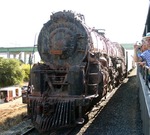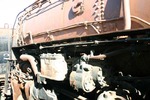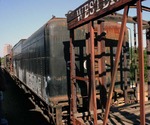Notes from a couple of old ATSF steam locomotives
 Friday, May 16, 2014 at 12:58PM
Friday, May 16, 2014 at 12:58PM To some they might be old rusty relics from another era. But wait until you hear their story. If they were to speak, what would they say? Would they tell us the many miles they ran in New Mexico? Would they tell us how the engine men like riding them? Would they tell you they were Santa Fe's finest in steam locomotive development?
Perhaps one would say:
Brilliantly designed by ATSF Mechanical Engr. H.H. Lanning and his team - days before there computer simulation models!
Born at Eddystone, Santa Fe's only builder of steam engines.
Santa Fe's 2-10-4 were inspired by C&O sucessful Class T-1 steam locomotives. ATSF No. 5021 operated between Fort Madison (IA), Bakersfield (CA) and San Bernardino (CA) - through Abo Pass, Cajon Pass, and over the Tehachapi Mtns. These 5011 class engines were one of Baldwin's best lugging long reefer blocks of California produce for eastern markets, or at sustained speeds of 70 mph pulling the Grand Canyon Limited. Equipped with 74-inch drivers, 310 boiler pressure, it developed over 5000 h.p. at speed or around 93,000 lbs in traction effort.*
Santa Fe's 4-8-4 No. 2925 was born during the war (1944) under a nickel steel shortage making them the heaviest Santa Fe 4-8-4s. Hailing from Clovis as home and assigned originally to pull freights between Argentine and Clovis, effectively replacing the Mikado. Dropped it's steam in 1956 . . . a mere youth of 12 years.
In early '57, only 5021 and 5027 (2-10-4) and 2907 and 3780 (4-8-4) were still in steam at Belen, NM - all the while Santa Fe's EMD GP9 fleet kept growing. Then on August 27, 1957, No. 5021 tied up for good after helping a freight up the Abo Pass. Even though they still have unexpired flue time, the economics of running a steam vs. diesel-electric locomotive, water issues in arid districts, and the recession of 1958 sealed Santa Fe's steam power fate for good. So for now we can only imagine them at speeds . . . waiting longer than they were alive . . . hoping for a new day to begin when they be made anew.
-----
Footnotes: This is a super-powered engine! Steam locomotives horsepower increases with speeds until it reaches train's rolling resistant and ability to make enough steam (boiler capacity). When the rolling resistance increases such as a grade through mountains, the steam engine horsepower drops while a diesel electric does not. Due to electric transmission, the horsepower is constant regardless of track speeds which is unlike a steam locomotive. It's why in the steam days, the engineer relied on slowly taking up the slack to start a heavy train which is different than today's diesel-electric powered train operations. The trade-off is that a steam locomotive can pull more tonnage after the train is moving than it can start a train, while a diesel-electric can start more tonnage than pull once the train gets going. EMD's entry into the road locomotive market at this time were the FT 4-unit diesel-electric which produced 5400 h.p. and developed 160,000 lbs of traction effort at 9.3 mph. Santa Fe conducted tests with FTs thru the Tehachapi and found that they out performs steam since it can keep the train moving at higher speeds. UP, KCS and N&W, to name a few, operated steam locomotives over 300 psi. The more pressure, the more energy - hence greater power.
Below: 2925 and 5021





Reader Comments